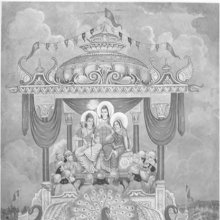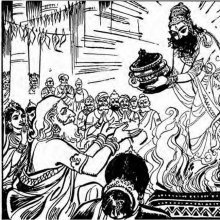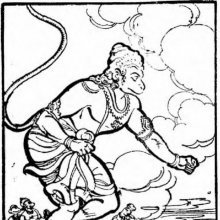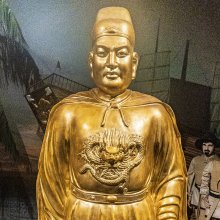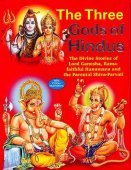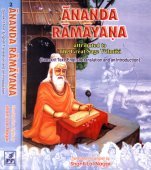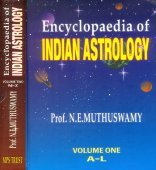Messenger: 1 definition
Introduction:
Messenger means something in Hinduism, Sanskrit. If you want to know the exact meaning, history, etymology or English translation of this term then check out the descriptions on this page. Add your comment or reference to a book if you want to contribute to this summary article.
Images (photo gallery)
In Hinduism
Shilpashastra (iconography)
Source: Shodhganga: Elements of Art and Architecture in the Trtiyakhanda of the Visnudharmottarapurana (shilpa)Messengers refers to a certain class of personalities which follows specific guidelines in the tradition of ancient Indian Painting (citra), according to the Viṣṇudharmottarapurāṇa, an ancient Sanskrit text which (being encyclopedic in nature) deals with a variety of cultural topics such as arts, architecture, music, grammar and astronomy.—The personalities like [e.g., Messengers], [...] are to be drawn to project them as noble and polite. The body complexion of an elephant rider and a messenger should be śyāma i.e., dark and kapila i.e., tawny in a picture respectively. Thus the Viṣṇudharmottarapurāṇa establishes the fact that even in the pictures; the people belonging to different class and profession [e.g., messengers] were projected with specific attire so that general people can equate the picture with the practical character.

Shilpashastra (शिल्पशास्त्र, śilpaśāstra) represents the ancient Indian science (shastra) of creative arts (shilpa) such as sculpture, iconography and painting. Closely related to Vastushastra (architecture), they often share the same literature.
See also (Relevant definitions)
Partial matches: Messenger, Te.
Query error!
Full-text (+883): Duta, Yamaduta, Devaduta, Duti, Dautya, Dutika, Narada, Rajaduta, Vacaka, Bhandila, Gramapreshya, Ahvayaka, Varttahara, Dutaka, Sasanahara, Vasantaduta, Meghaduta, Ajamila, Yamadutaka, Samdeshahara.
Relevant text
Search found 275 books and stories containing Messenger, Messengers, Sanansaattaja, The messenger, Viestit; (plurals include: Messengers, Messengerses, Sanansaattajas, The messengers, Viestits). You can also click to the full overview containing English textual excerpts. Below are direct links for the most relevant articles:
Charaka Samhita (English translation) (by Shree Gulabkunverba Ayurvedic Society)
Chapter 12 - Prognosis from Powder resembling Cow-dung Powder (gomaya-curna) < [Indriyasthana (Indriya Sthana) — Section on Sensorial Prognosis]
Chapter 29 - The Ten Resorts of Life (Dasha-Prana-Ayatana) < [Sutrasthana (Sutra Sthana) — General Principles]
Chapter 1 - Prognosis from voice and complexion (varna-svara) < [Indriyasthana (Indriya Sthana) — Section on Sensorial Prognosis]
Rig Veda (translation and commentary) (by H. H. Wilson)
Maha Prajnaparamita Sastra (by Gelongma Karma Migme Chödrön)
Appendix 1 - Resemblance of a city with the body (kāya) < [Chapter XI - The Ten Comparisons]
Part 8 - Origin of the name Ānanda < [Chapter VI - The Great Bhikṣu Saṃgha]
The Caturdevarājasūtra < [Section II.1 - Morality of the lay person or avadātavasana]
Heimskringla (by Snorri Sturlson)
Part 196 - Of Bjorn The Marshal < [Chapter VII - Saga Of Olaf Haraldson]
Part 57 - King Olaf's Messengers < [Chapter VII - Saga Of Olaf Haraldson]
Part 3 - Of Gyda, Daughter Of Eirie < [Chapter III - Harald Harfager's Saga]
Bhaktavijaya: Stories of Indian Saints (by Justin E. Abbott)
52.9: Many messengers go from Chinchwad: none return < [Chapter 52 - Tukaram (Continued)]
37.10: The King demands the elephant < [Chapter 37 - Rasik Murar]
39.3: Kanhopatra’s death at Pandharpur < [Chapter 39 - Kanhopatra]
Annadatri-carita (study) (by Sarannya V.)
1. Dramatic aspects (b): Neta (Hero of the Drama) < [Chapter 4 - Dramatic Appraisal of Annadatri-carita]
1. Dramatic aspects (c): Rasa (sentiment) < [Chapter 4 - Dramatic Appraisal of Annadatri-carita]
5. Character Analysis of Annadatri-Carita < [Chapter 3 - An Introduction to Annadatri-carita]
Related products
